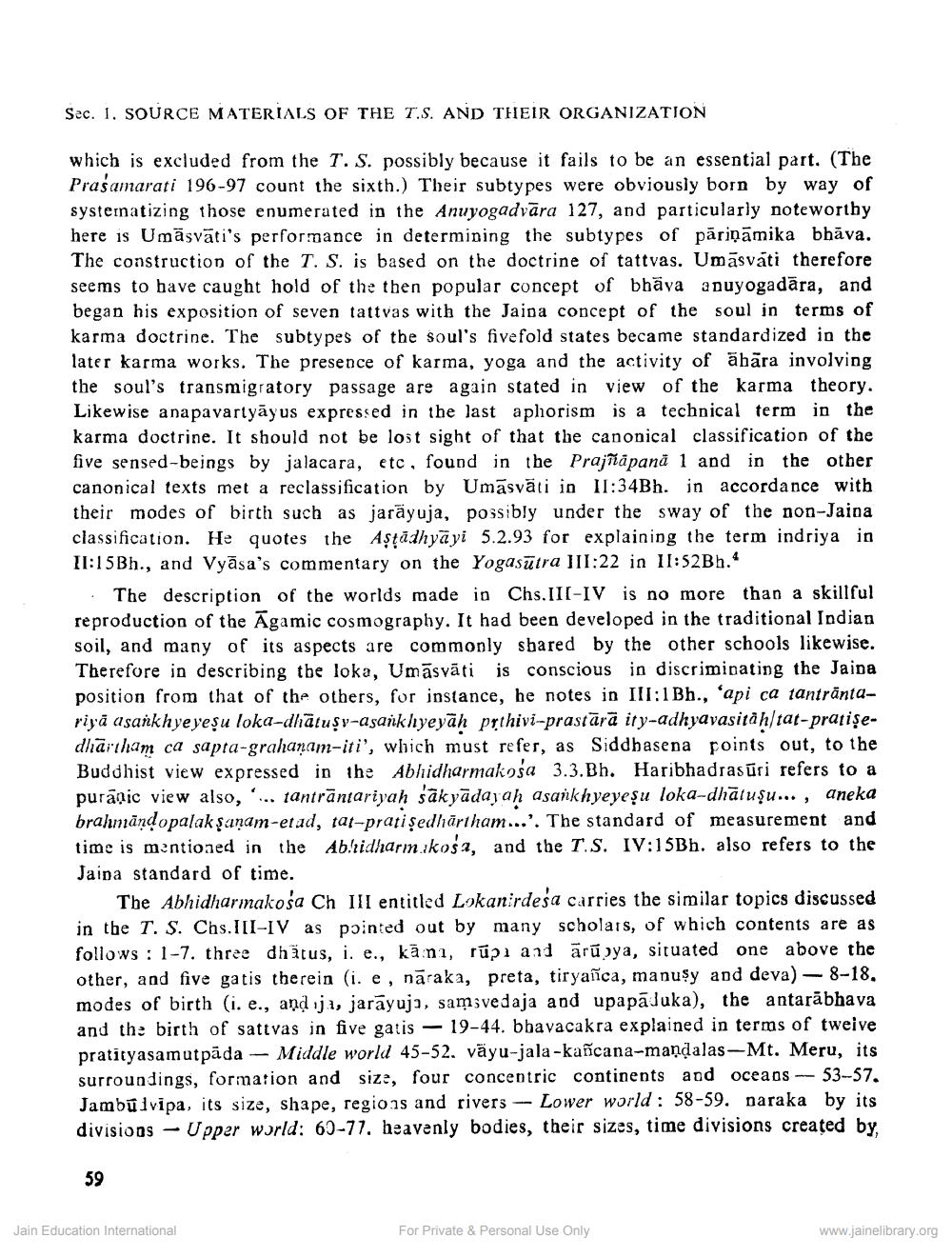________________
Sec. 1. SOURCE MATERIALS OF THE T.S. AND THEIR ORGANIZATION
which is excluded from the T. S. possibly because it fails to be an essential part. (The Prasamarati 196-97 count the sixth.) Their subtypes were obviously born by way of systematizing those enumerated in the Anuyogadvāra 127, and particularly noteworthy here is Umāsvāti's performance in determining the subtypes of pāriņāmika bhāva. The construction of the T. S. is based on the doctrine of tattvas. Umāsvati therefore seems to have caught hold of the then popular concept of bhäva anuyogadāra, and began his exposition of seven tattvas with the Jaina concept of the soul in terms of karma doctrine. The subtypes of the soul's fivefold states became standardized in the later karma works. The presence of karma, yoga and the activity of ähāra involving the soul's transmigratory passage are again stated in view of the karma theory. Likewise anapavartyāyus expressed in the last aphorism is a technical term in the karma doctrine. It should not be lost sight of that the canonical classification of the five sensed-beings by jalacara, etc, found in the Prajñāpanā 1 and in the other canonical texts met a reclassification by Umāsvāti in II:34Bh. in accordance with their modes of birth such as jaräyuja, possibly under the sway of the non-Jaioa classification. He quotes the Astādhyāyi 5.2.93 for explaining the term indriya in II:15Bh., and Vyāsa's commentary on the Yogasūtra JII:22 in 11:52Bh."
• The description of the worlds made in Chs. III-IV is no more than a skillful reproduction of the Āgamic cosmography. It had been developed in the traditional Indian soil, and many of its aspects are commonly shared by the other schools likewise. Therefore in describing the loka, Umāsvāti is conscious in discriminating the Jaina position from that of the others, for instance, he notes in III:1 Bh., 'api ca tanträntariyā asankhyeyeșu loka-dhātuşy-asankhyeyāh prthivi-prastārā ity-adhyavasitah/ tat-pratiședhārtham ca sapta-grahanam-iti', which must refer, as Siddhasena points out, to the Buddhist view expressed in the Abhidharmakosa 3.3.Bh. Haribhadrasűri refers to a purānic view also, ... tantrāntariyah sakyādajah asankhyeyeșu loka-dhātuşu... , aneka brahmānd opalak şanam-etad, tat-pratişedhārtham...'. The standard of measurement and time is mentioned in the Abridharm kosa, and the T.S. IV:15Bh. also refers to the Jaipa standard of time.
The Abhidharmakośa Ch III entitled Lokanirdesa carries the similar topics discussed in the T. $. Chs.III-IV as pointed out by many scholars, of which contents are as follows : 1-7. three dhätus, i. e., kāni, rūpi and ārūpya, situated one above the other, and five gatis therein (i. e, nāraka, preta, tiryanca, manusy and deva) — 8-18. modes of birth (i. e., and ja, jarāyuja, samsvedaja and upapāduka), the antarābhava and the birth of sattvas in five gatis - 19-44. bhavacakra explained in terms of twelve pratityasamutpāda - Middle world 45-52. väyu-jala-kañcana-mandalas-Mt. Meru, its surroundings, formation and size, four concentric continents and oceans - 53-57. Jambu ivipa, its size, shape, regions and rivers -- Lower world : 58-59. naraka by its divisions - Upper world: 60-77. heavenly bodies, their sizes, time divisions created by
59
Jain Education International
For Private & Personal Use Only
www.jainelibrary.org




